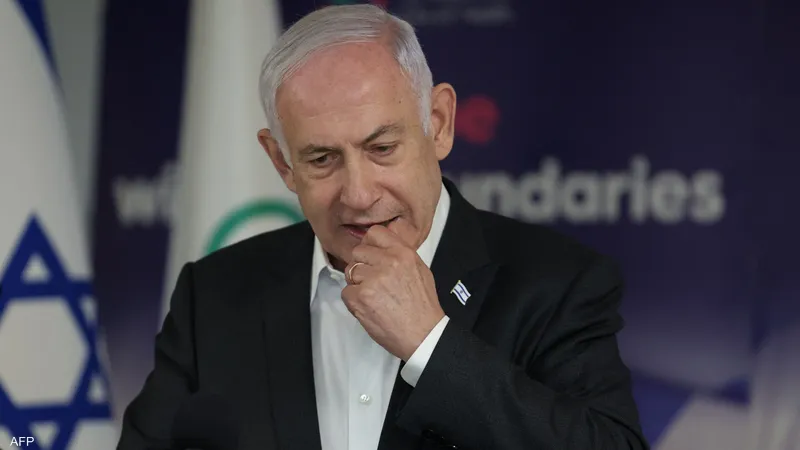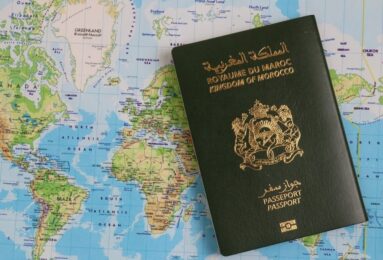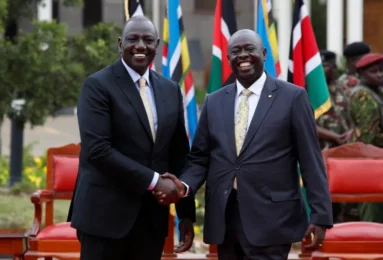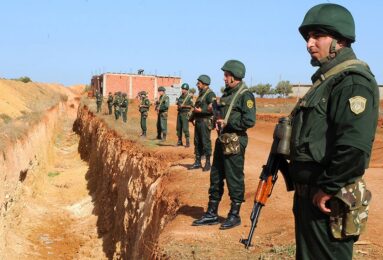Israeli Prime Minister Benjamin Netanyahu spoke to a group of media outlets during a press conference in Tel Aviv to explain his insistence on remaining in the Philadelphia Corridor between the Gaza Strip and Egypt. During the press conference, Netanyahu showed a map of Morocco without the disputed Western Sahara, for the fourth time in a row, despite recognizing Rabat’s “sovereignty over the territory,” which is not autonomous according to the United Nations.
Most political analysts consider the Israeli prime minister’s display of a map of Morocco without the disputed Western Sahara, for the fourth time in a row, to be a “deliberate act.”
Although it has been said that displaying the map without Western Sahara was “just a mistake,” political analysts’ assessments rule this out, and instead suggest that it may come in the context of a shift in the US position on the Western Sahara issue since the Biden administration took office.
The Biden administration refused to open the US consulate in Dakhla and allocate $3 billion to “support investment in the Sahrawi territories,” as stipulated in the tripartite agreement between Morocco, the United States and Israel, signed during the Trump administration, in exchange for normalizing relations with Israel and Morocco.
The third time Netanyahu showed a map of Morocco without the Western Sahara, he was accompanied by US Secretary of State Antony Blinken, who was holding talks as part of a tour of the Middle East, as part of US pressure to accelerate steps to reach a truce agreement between the Palestinian resistance movement Hamas and Israel.
Perhaps one of the most notable analyses pointing to an important element in Israel’s “deliberate provocation of Rabat” was a report by Middle East Eye, which noted that the map Netanyahu widely displayed on Monday “swallowed the occupied West Bank from the map of Palestine and annexed it to Israel,” while Western Sahara was cut off from the Moroccan map despite “Israeli recognition.”
The Palestinian Foreign Ministry said in a statement that the use of the map is a “blatant recognition of Israel’s colonialist and racist agenda.”
Netanyahu has appeared several times with maps of Morocco that exclude Western Sahara, which has sparked controversy. The first incident occurred in May 2024, when Netanyahu showed a map depicting Western Sahara separate from Morocco, which Israel described as an “inadvertent mistake.” A similar “mistake” was repeated in September 2024, leading to another round of mockery of Morocco. Israel apologized again, and the situation continued for up to 4 times.
On July 23, 2023, a statement from the Moroccan Royal Court said that the Israeli Prime Minister informed King Mohammed VI of “the decision of the State of Israel to recognize Morocco’s sovereignty over the territory of Western Sahara.”
The statement added that the Israeli prime minister emphasized that his country’s position “will be reflected in all relevant actions and documents of the Israeli government.”
Armed conflict
Western Sahara covers an area of 252,000 kilometers on the northwestern coast of the African continent. It is a sparsely populated region with a population of 567,000 according to United Nations and World Bank statistics.
The Polisario Front began its first military war with Spain, which was occupying the region, but in 1976 Spain would withdraw from the region under the Madrid Agreement, which gave Morocco and Mauritania joint administrative control over the territory.
Israeli Prime Minister Benjamin Netanyahu spoke to a group of media outlets during a press conference in Tel Aviv to explain his insistence on remaining in the Philadelphia Corridor between the Gaza Strip and Egypt. During the press conference, Netanyahu showed a map of Morocco without the disputed Western Sahara, for the fourth time in a row, despite recognizing Rabat’s “sovereignty over the territory,” which is not autonomous according to the United Nations.
Most political analysts consider the Israeli prime minister’s display of a map of Morocco without the disputed Western Sahara, for the fourth time in a row, to be a “deliberate act.”
Although it has been said that displaying the map without Western Sahara was “just a mistake,” political analysts’ assessments rule this out, and instead suggest that it may come in the context of a shift in the US position on the Western Sahara issue since the Biden administration took office.
The Biden administration refused to open the US consulate in Dakhla and allocate $3 billion to “support investment in the Sahrawi territories,” as stipulated in the tripartite agreement between Morocco, the United States and Israel, signed during the Trump administration, in exchange for normalizing relations with Israel and Morocco.
The third time Netanyahu showed a map of Morocco without the Western Sahara, he was accompanied by US Secretary of State Antony Blinken, who was holding talks as part of a tour of the Middle East, as part of US pressure to accelerate steps to reach a truce agreement between the Palestinian resistance movement Hamas and Israel.
Perhaps one of the most notable analyses pointing to an important element in Israel’s “deliberate provocation of Rabat” was a report by Middle East Eye, which noted that the map Netanyahu widely displayed on Monday “swallowed the occupied West Bank from the map of Palestine and annexed it to Israel,” while Western Sahara was cut off from the Moroccan map despite “Israeli recognition.”
The Palestinian Foreign Ministry said in a statement that the use of the map is a “blatant recognition of Israel’s colonialist and racist agenda.”
Netanyahu has appeared several times with maps of Morocco that exclude Western Sahara, which has sparked controversy. The first incident occurred in May 2024, when Netanyahu showed a map depicting Western Sahara separate from Morocco, which Israel described as an “inadvertent mistake.” A similar “mistake” was repeated in September 2024, leading to another round of mockery of Morocco. Israel apologized again, and the situation continued for up to 4 times.
On July 23, 2023, a statement from the Moroccan Royal Court said that the Israeli Prime Minister informed King Mohammed VI of “the decision of the State of Israel to recognize Morocco’s sovereignty over the territory of Western Sahara.”
The statement added that the Israeli prime minister emphasized that his country’s position “will be reflected in all relevant actions and documents of the Israeli government.”
Armed conflict
Western Sahara covers an area of 252,000 kilometers on the northwestern coast of the African continent. It is a sparsely populated region with a population of 567,000 according to United Nations and World Bank statistics.
The Polisario Front began its first military war with Spain, which was occupying the region, but in 1976 Spain would withdraw from the region under the Madrid Agreement, which gave Morocco and Mauritania joint administrative control over the territory.
The war between Polisario and Morocco continued until a ceasefire agreement was signed in 1991. But in 2020, Polisario Front leader Ibrahim Ghali issued a decree ending the ceasefire with Morocco, which led to a military confrontation between the two sides that continues today, due to Morocco’s deployment of its troops in the buffer zone, in response to what Rabat said was the “provocation” of Polisario, who blocked the road to the Guergarat area, a gateway to Mauritania.
The Polisario Front insists on a referendum for self-determination, as stipulated in the ceasefire agreement signed between the two sides in 1991.
Refugees
During the war years, many Sahrawis took refuge in Algeria, where they have been living in camps for decades.
According to the Algerian government’s UNHCR website, there are 165,000 Sahrawi refugees in the five camps near Tindouf.
Leveling up
The United Nations has been involved in efforts to resolve the Western Sahara conflict for decades, primarily through peacekeeping and diplomatic initiatives.
The UN’s original goal was to organize a referendum to allow the people of Western Sahara to determine their future – either independence or integration with Morocco. However, this referendum was never held due to disagreements over voter eligibility and other issues.
On October 6, 2021, the United Nations appointed Staffan de Mistura as special envoy for Western Sahara, which the Polisario Front accepted, but Morocco rejected this appointment, and under US pressure, he later accepted it.
Staffan de Mistura is supported by Washington and most European capitals in his mission to reach an agreed solution between the two parties to the conflict.







